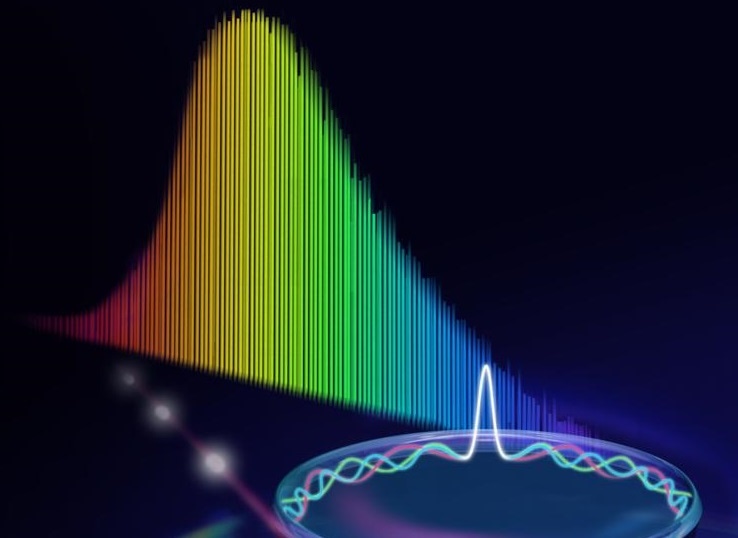Russian physicists have developed a technique for significantly narrowing the emission spectrum of a standard diode laser. The research was published on October 26th in Nature Photonics and was co-authored by researchers from the Russian Quantum Center (RQC), the Moscow Institute of Physics and Technology (MIPT), Lomonosov Moscow State University (MSU), and Samsung R&D Institute Russia.
This makes their device a valuable replacement for the more complex and costly single-frequency lasers, enabling the development of compact chemical analyzers that can be fitted into a smartphone, inexpensive lidars for self-driving cars, as well as security and structural health monitoring devices on gas pipelines, bridges, and elsewhere.
Applications for lasers are numerous. Among them are laser sights, laser eye surgery, and fiber optic communication. One of the core uses of lasers is spectroscopy, which measures the exact chemical composition of almost anything.

The paper’s lead author RQC Scientific Director Michael Gorodetsky said: “This work has two main results. First, it serves to show that you can make a cheap narrow-linewidth laser, which would be single-frequency yet highly efficient and compact. Secondly, the same system with virtually no modifications can be used for generating optical frequency combs. It can thus be the core component of a spectroscopic chemical analyzer.”
An optical laser frequency comb can be employed as a “ruler” to correctly measure light frequency and thus make exact spectrometric measurements. Other applications include accurate time data transfer, satellite navigation, and the radial velocity technique for locating extrasolar planets. The so-called optical frequency comb method underlies laser-based spectroscopy, invented by the 2005 Nobel laureates in physics, John Hall from the U.S. and Theodor Hänsch from Germany. The two laureates built a laser device that produces optical radiation at a million extremely stable frequencies. The radiation in the gain medium of such lasers “bounces” between mirrors and is eventually released as a continuous train of short pulses of light of a million different colors. Each pulse persists mere femtoseconds—millionths of a billionth of a second. The emission spectrum of such a laser contains a significant number of uniformly spaced narrow spectral lines, the “teeth” of the optical comb.
It turned out that there is a simpler way to produce frequency combs, which depends on optical microresonators. These are ring- or disk-shaped transparent parts. As a result of their material’s nonlinearity, they alter pump laser radiation into a frequency comb, also stated as a microcomb.
“Optical microresonators with whispering gallery modes were first proposed at MSU’s Faculty of Physics in 1989. They offer a unique combination of submillimeter size and an immensely high-quality factor,” explained study co-author, MIPT doctoral student Nikolay Pavlov. “Microresonators open the way toward generating optical combs in a compact space and without using up much energy.”
All lasers cannot be used to pump optical frequency combs in a microresonator. The laser has to be powerful as well as monochromatic. The latter means that the light it discharges has to fall into a very narrow frequency band. Currently, the most common and economical lasers are diode lasers. Although they are compact and appropriate, in spectroscopy they fall short of more complex and costly devices. The reason is that diode lasers are not satisfactorily monochromatic: The radiation they release is “smeared” across a 10-nanometer band.
“To narrow down the linewidth of a diode laser, it is usually stabilized using an external resonator or a diffraction grating,” explained Gorodetsky. “This reduces the linewidth, but the cost is a major decrease in power, and the device is no longer cheap, nor is it compact.”
The scientists found a simple and smart solution to the issue. To make laser light more monochromatic, they used the same microresonators that produce optical frequency combs. That way they succeeded in retaining almost the same laser power and size—the microresonator is mere millimeters across—while also boosting monochromaticity by a factor of nearly 1 billion. To be exact, the transmission band is narrowed down to attometers—billionths of a billionth of a meter—and an optical frequency comb is produced, if required.
The suggested design has many probable applications. One of them is in telecommunications, where it would significantly improve the bandwidth of fiber optic networks by increasing the number of channels. Another domain that would profit is the design of sensors, such as reflectometers used as the foundation of security and monitoring systems. For instance, if a fiber optic cable runs along an oil pipeline or a bridge, the light in the cable will respond to the smallest disturbances or variations in the object’s geometry, isolating potential problems.
Single-frequency lasers can be employed in lidars, or optical radars, which are fitted on self-driving cars, among other uses. Lastly, the technology enables extremely precise analyzers, such as those measuring the composition of air or running medical diagnostics that could be combined into watches or smartphones.
The Russian Science Foundation supported this study.